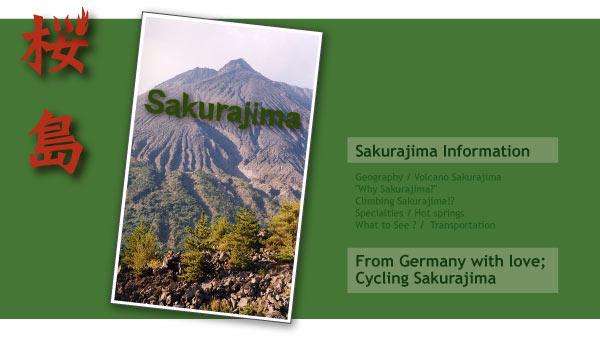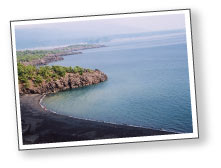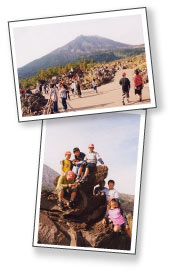
| GEOGRAPHY It is thought that Sakurajima first became active about 13000 years ago. Sakurajima with a circumference of about 52km is the one of 4 biggest volcanos in Japan : Mt. Mihama (near Tokyo), Mt. Asama (Gunma Pref.), Mt. Aso (Kumamoto) and Sakurajima. Sakurajima is created by 3 peaks of the North peak, Kitadake (1117m high), the middle peak Nakadake (1060m) and the South peak Minamidake (1040m). Now, the South peak is only active. 60 % of Sakurajima is Shirasu which is light sand. 
|
VOLCANO
SAKURAJIMA Sakurajima has been changing its shape by repeated eruptions. There are many eruptions recorded in history. There were four major eruptions in history which is Bunmei eruption (1476), Anei eruption (1779), Taisho eruption (1914) and Showa eruption (1946). In the Anei eruption, over 140 people died. Sakurajima island was joined to the peninsula in the Taisho eruption in 1914. The smoke from the Taisho eruption rose up to over 8000m, and the ash was blown as far as the Kamchatka Peninsula in Russia. About 3 million tons of lava gushed out of the volcano for about one month. The lava flowed and buried Karasujima where was located about 500 m off shore of Sakurajima, and joined the Sakurajima island to the Osumi peninsula. 35 people died and 23 were reported missing in the Taisho eruption. Now, only the South peak has been active for 30 years ago. |
"Why
SAKURAJIMA?" In literally, Sakurajima means Cherry blossom island. Some people think that it named Sakurajima because there are many cherry blossom trees in Sakurajima. It would be very beautiful if Sakurajima was filled with pink cherry blossoms..... but, it is not. There are many sayings about name. One saying is like this. Goddess called "Konohana Sakuyahime" who appeared in legend was defied in Sakurajima, so that people used to call the island as "Sakuya-jima (Sakuya island)". But the name changed to "Sakura-jima" in history. One is saying that when this island was created, cherry blossoms were also floated over the sea around the island. Or It was taken from the name of "Sakurajima Tadanobu" who was a local dignitary. |
| CLIMBING
SAKURAJIMA?! People used to climb Sakurajima until about 50 years ago. Many students climbed Sakurajima as a school trip. Students climbed to the peak of mountain and even to inside of the crater. At that time, many people visited Sakurajima for hiking. Now, climbing Sakurajima more than the 4th stage where Yunohira observatory is not allowed. 
|
SAKURAJIMA
SPECIALITIES The most well known products of Sakurajima are the world's largest Sakurajima daikon radish and the World's smallest Sakurajima mandarin. Both are raised in Sakurajima's volcano ash soil. Sakurajima radish is called "Shima-dekon" by the local. It is the biggest and heaviest radish which is recorded on the Guinness Record. The record is now 29.6kg!! Sakurajima radish is more juicy and tender than other radishes. The harvest time is around December. "The World Biggest Sakurajima daikon radish contest" is held in Sakurajima every year. It can be eaten cooked with soy sauce, dried in strips or pickles. Sakurajima mandarine or "Shima-mikan" is about 3cm in a diameter. It is more sweet than other mandarine. Many other vegetable and fruit like "Biwa (Japanese loquat)" are produced. In May or June, you can see it covered with white paper bags. It is to protect the fruit from harmful insects and volcanic ash. Sakurajima pottery: There are two pottery kilns in Sakurajima. Both are made with glaze which contains volcanic ash. |
HOT
SPRINGS Volcano Sakurajima brought us treasure of hot-spring. Located along the seashore in the South of Sakurajima is Furusato Hot Springs. Four inns and hotels line the road at Furusato Hot Springs, each has outdoor hot springs. At the Furusato Kanko Hotel, you have to wear white "yukata (cotton kimono)" to take outside hot spring. The view of Kagoshima City and bay while soaking in the outdoor hot spring is splendid!! I recommend to go there just before the sun sets. There are 2 other Hot Springs; Sakurajima Magma Hot Spring near Sakurajima port, and Shirahama Hot Spring Center in the North of Sakurajima. Shuttle buses for Furusato Hot Spring and Shirahama Hot Spring are available from the port. |
|
Do you have an idea how many tourists from abroad visit Kagoshima
? After getting off from the ferry in Sakurajima, we headed to the left where a residence area is near the Sakurajima port, and the road is smooth and extended by the bay. We saw the fish cages in which fishermen told us, they culture "Kampachi" and "Yellow tail", very common fishes in the area. After a while, we reached Saidou beach, which is the only natural beach in Sakurajima. For the German people, that wasn't certainly the idea of beach though. Mr.
Wolfgang got a flat tire, but fortunately we found a very kind
man who helped him to change his bike at the bicycle renting store.
In the meanwhile, the rest of the group took a break and rest
on a nice small beach with black and brown small light stones,
next to a small fishing port. One of the guys finally decided
to swim, so changed clothes and jumped in the water: This was
the first time to swim in the Pacific he said!! Others walked
along the beach picking up shells and wood. When
Mr. Wolfgang came back with a new "mama-chari" (usually
for ladies), we started our trip. After a while, the road became
gradually an upward slope. We started to see many brown pine trees
and it was quite strange since pine trees don't change color with
seasons. We knew later that pine trees have been dying, due to
a special insect that attacks them. The
bay disappeared from our sight and the road slope became quite
steep, so that we walked for a while. Once we got the top downhill
was very nice and curves were exiting! There was a small wooden
cottage with some cars parked in front. We stopped by, and an
old woman was selling Sakurajima small sweet mandarins and bottles
of golden colored camellia oil. On the ground, seeds of camellia
to produce oil were placed to dry. People use the oil for the
hair. After drinking juice we continued our trip. We
realized how Sakurajima has some small bays with artistic shape
lava rocks, greenery pine trees, a clear dark green sea and many
fishing boats inside. When you see it from the hill, these bays
look like hidden secret bays. In
the East side of Sakurajima, we didn't found many houses; only
sea or green. From the foot of the mountain to mid way up the
side, you could see only greenery fields, but somehow they were
strange. Looking carefully you were not able to see single trees
and most trees were covered by a weed like ivy. It looked like
as if you put over a huge net of ivy on the field from the air. Houses
appeared gradually and finally we reached the buried gate, which
is a Shintoist shrine gate buried by lava in the huge eruption
of 1914. This is the only thing that remains from former eruptions.
The place is often visited by tourists; during our stay there,
we saw around 8 groups, including a Polish one. We
headed then to the place where Sakurajima and Osumi peninsula
are connected, downhill most of the time. The traffic became heavier
and we had to be careful, since cars passed quite close to us.
Even though the view of Osumi peninsula and Kinko bay was wonderful.
For the German people this was the real Japanese Kagoshiman scenery.
Not far from After
the lava road, we saw a residence area and after it we found a
"Sakurajima-yaki kiln", which is Sakurajima pottery
made with glaze containing volcanic ash and using hot spring water.
They are usually shiny black or dark brown color and it is one
of Sakurajima's specialties. We finally arrived to Sakurajima port again. We all were quite tired but really satisfied with our bike tour around Sakurajima. |
 
|
